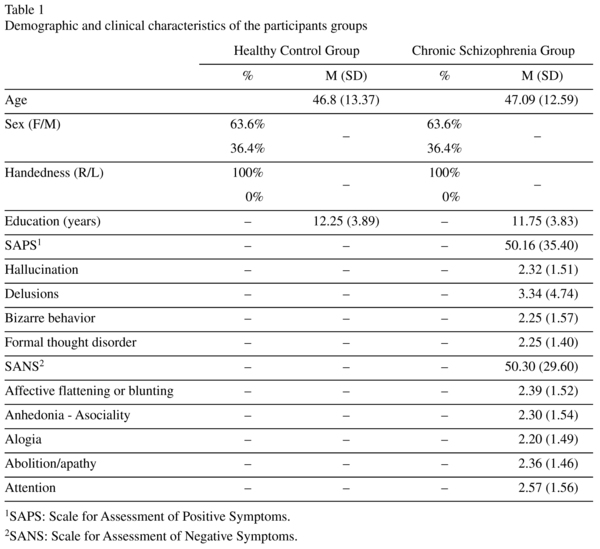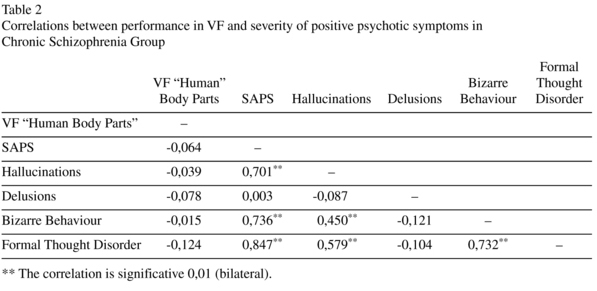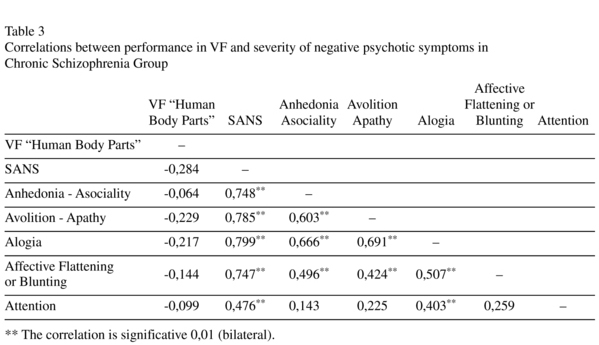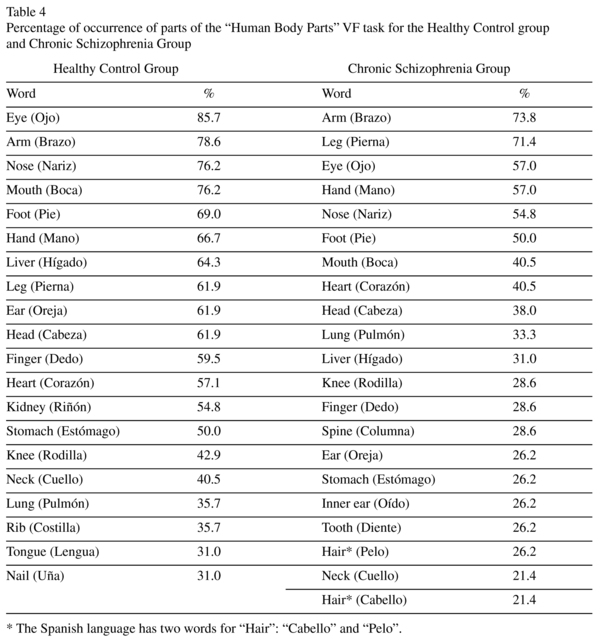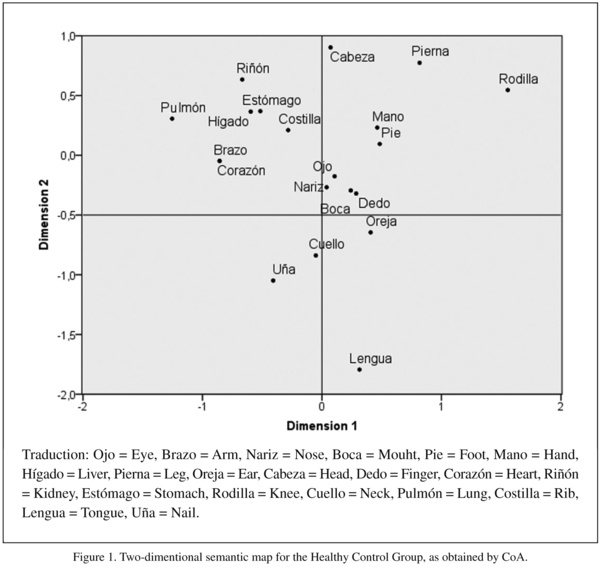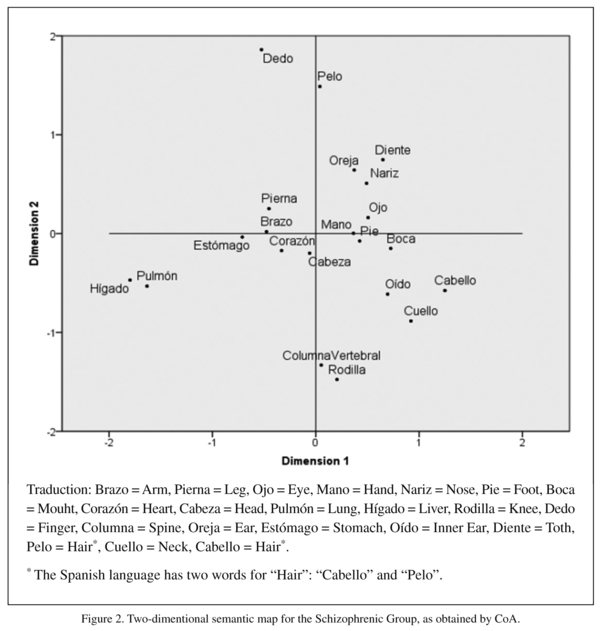My SciELO
Services on Demand
Journal
Article
Indicators
-
 Cited by SciELO
Cited by SciELO -
 Access statistics
Access statistics
Related links
-
 Cited by Google
Cited by Google -
 Similars in
SciELO
Similars in
SciELO -
 Similars in Google
Similars in Google
Share
The European Journal of Psychiatry
Print version ISSN 0213-6163
Eur. J. Psychiat. vol.30 n.2 Zaragoza Apr./Jun. 2016
Semantic memory organization on verbal fluency test "Human Body Parts" in patients with chronic schizophrenia diagnosis and healthy controls
Guillermina Bertoa and Flavia S. Galavernaa,b,c
a Laboratory of Experimental Psychology. Department of Psychology, National University of Córdoba, Córdoba. Argentina
b Neuropsychology Research Department. Institute of Cognitive Neurology (INECO), Buenos Aires. Argentina
c Scientific and Technical Research Council (CONICET), Buenos Aires. Argentina
ABSTRACT
Background and Objectives: The cognitive impairments known as schizophrenia have been extensively reported in the literature. The severity of such impairments has been shown to vary depending on the cognitive domain that is being studied. Impairments in performance in VF tasks have also been extensively reported by comparing schizophrenic patients on the one hand with healthy controls and patients suffering from other mental disorders on the other, and it is suggested that such impairments can be considered as part of the neuropsychological endophenotype for schizophrenia. This study analyzed the organization of semantic memory in patients with chronic schizophrenia by means of the "Human Body Parts" VF task.
Methods: 44 patients with chronic schizophrenia and 44 healthy controls were examined, paired by age, sex, years of education, and handedness. The organization of semantic memory was derived from the construction of semantic maps obtained by means of correspondence analysis.
Results: Performance in the VF task studied was significantly lower in the patients group. The semantic maps obtained from the CoA show a semantic organization partly differential in both groups of participants.
Conclusions: The hypothesis that there would be better performance because this is a test that has a self-referential key was partially rebutted. Although there was a deficit in performance, the findings from this study suggest that such performance cannot be accounted for by lack of organization in semantic networks or clinical variables.
Keywords: Semantic organization; Verbal fluency; Body parts; Chronic schizophrenia.
Introduction
Schizophrenia is a mental disorder characterized by disruption in a person's social, cognitive and affective life, in a set of functions which are seen as specific to human beings1. Within the area of cognitive functioning, the range of deficits is very wide, with attention, memory and executive functions as the most affected ones2. Among such deficits, those in semantic memory have been extensively reported in schizophrenia3-7, semantic memory is considered as a "mental dictionary" where language rules and word meanings are stored8.
One of the methods reported in the literature for accessing semantic systems is a Verbal Fluency (VF) task9 which consists in asking the subjects to say out loud as many words as they can in a set period of time (usually 60 seconds) and according to a given criterion, for example, words beginning in a particular letter (Phonological Verbal Fluency, PVF) or words belonging to a specific semantic category (Semantic Verbal Fluency, SVF). These two types of VF have been associated to differential activation of brain regions; PVF, for example, would demand the activation of the prefrontal regions of the cerebral cortex, while SVF would produce greater activation in temporal regions of the cortex. This has led different authors to hypothesize that PVF might be related to a greater extent with executive processes, such as the generation of strategies for word retrieval based on a stimulus that is more abstract than the one presented in SVF, where words are retrieved from a semantic category with a lesser demand on executive processes and a higher demand on the semantic store9.
The type of analysis usually carried out with these tasks consists in quantifying the total production of words. However, some research studies, by means of qualitative analysis of performance in the test, that is, the word-profiles produced, have helped investigate how concepts are organized during spontaneous retrieval7,9,10.
In VF tasks, words tend to be retrieved by semantic or phonological associations; therefore, a qualitative analysis of these words may help explore the organization of semantic memory. Concepts are represented as semantic nodes, and their properties as links between these nodes. Such links may carry different weight depending on their relevance to the meaning of the concept or on the prevalence of phonological similarity. This means that the more properties two nodes have in common, the closer their mutual proximity will be in the network. Furthermore, when a concept is remembered, activation spreading occurs between associated nodes in a degree of intensity that decreases as the distance between the links joining them increases11.
When a qualitative analysis is performed on word-profiles generated in a VF task, two phenomena become observable: switching and grouping. The former is regarded as the ability to switch to other subcategories when one has been exhausted, while the latter is the production of semantically or phonologically related words to form subcategories12. It has been postulated that grouping may be related to processes in semantic memory, with activation of temporal regions of the cortex. It has been proposed, on the other hand, that switching may depend on activation of the prefrontal cortex, involving processes such as strategic search of words, cognitive flexibility, and attention13.
Another way of accessing the organization of semantic memory is by means of multivariate statistical analyses, such as multidimensional escalation analysis and correspondence analysis, which allow for the construction of semantic maps by studying the closeness or distance between concepts retrieved in VF tasks. The distances between words represented in the map allow to track the proximity from which they have been retrieved and therefore to form groupings that may reflect organizations by dimension, category, or phonology, among other types.
Authors who have studied semantic organization by means of this type of methodology of analysis have reported a lack of organization in the semantic maps of patients with schizophrenia as compared to those of healthy controls4,6,7. For example, Paulsen et al.7 identified, by means of multidimensional escalation, two clearly distinct dimensions in the Healthy Control Group, namely that of domesticity and that of size, which were not found in the Chronic Schizophrenia Group. These results coincide with those later found by Sumiyoshi et al.6 and Galaverna et al.4.
The studies carried out so far have used the "Animals" category for PVF and SVF tasks, which imply not only the job of retrieving concepts from the semantic memory but also a demand on executive processes. Depending on the task, those executive processes involve a greater or lesser ability for abstraction, which is often deteriorated in schizophrenia14-16.
The aim of this study was to analyze the performance and the semantic organization of patients with chronic schizophrenia and of healthy controls in a "Human Body Parts" type of SVF task. Some studies have analyzed the performance in this type of task in healthy individuals17,18 and in some diseases, such as Alzheimer's or Parkinson's disease19 and few studies on psychiatric disorders such as Schizophrenia20. In most studies reported comparisons in the production of words between various semantic tasks and "Human Body Parts" VF; where the increase of spontaneous recovery of words is greater in the latter, highlighting a facilitator effect. This may be because the level of abstraction is lower since it implies the possible use of a self-referential key, namely the person's own body21. Le Clec'H et al.22 propose that there exists a particular circuit for the processing of information about body parts, which may include the left interparietal fissure, the left precentral fissure, and the medial frontal gyrus. This would imply that, if there existed certain specificity in the way we process this type of concepts; differences might be found in the number of retrieved words and the organization of these words.
Materials and methods
Participants
88 participants aged 18 to 75 took part in this study. Of these, 44 had a diagnosis of chronic schizophrenic disorder23 and were receiving care either in "San Nicolás" private mental health clinic or in "Profesor León Morra" state-run hospital, in Córdoba City, Argentina; and 44 were healthy individuals (the Healthy Control Group), paired according to age, years of education, handedness, and sex with the patients that made up the Chronic Schizophrenia Group. The healthy control participants were volunteers from the Faculty of Psychology, from "Pueyrredón" Retirement Center, and others. Excluded from this study were individuals with fewer than 3 years of education, and those with a history of stroke, craniocerebral injury, coma, epilepsy, loss of consciousness for over 20 minutes or other diseases of the nervous system, and substance abuse. For the patients group, it was required that the medication should not have been modified in the previous 30 days.
Table 1 shows the descriptive results for the socio-demographic and clinical-psychiatric variables.
Measures
Symptom assessment
- Scale for Assessment of Positive Symptoms (SAPS) - Spanish version24: The SAPS was used to assess the display of positive psychotic symptoms of the participants as it is specifically designed to assess this kind of symptoms.
- Scale for Assessment of Negative Symptoms (SANS) - Spanish version25: The SANS was used to evaluate the negative psychotic symptoms due to its specificity in assessing psychotic symptoms present in schizophrenia.
Neuropsychological measures
Verbal Fluency Test "Human Body Parts": It is a word-naming task. All participants were given the versions of "Human Body Parts" category VF test. The participant is asked to say out loud as many "Human Body Parts" as they can in a set period of time (60 seconds). The only restriction was not to repeat parts of the body that have already been said. All responses were digitally recorded for later analysis.
Data analyses
Normal distribution of the results was tested using the Shapiro-Wilk test. T-test was used for differences between the two groups.
The correlations between performance in VF and severity of psychotic symptoms was analyzed using bivariate correlation coefficient of Pearson.
Correspondence analysis (CoA) was used to construct the semantic maps. First, a ranking of the 20 most frequent words was established, and then these were arranged into a double-entry table where "0" indicated absence of the word and "1" indicated occurrence. Thus, a simplified representation of the distance between words and their degree of association was obtained. The distribution in the dimensional space is determined by inertia, which is the average distance between the words and their respective center of gravity. The total inertia in the dot cloud relative to their center of gravity is a measure of dispersal of the cloud and is calculated as the weighted sum of the distances between the dots in a column (words) and the center of gravity in the cloud, using the mass of each word as weighting and Chi-square distance26 as measurement. From this point on, each word was projected onto the correspondence map axes.
Thus, the CoA allowed us to obtain a graph containing the words and the subjects, and to measure the distance between such words and how they relate to one another. If, for example, two subjects produce similar word-profiles, these profiles will be more likely to be located close to each other in the CoA map9,13.
Results
Performance of the Healthy Control Group and the Chronic Schizophrenia Group in Human Body Parts SVF
The results showed significant differences between the two groups in terms of performance in the Human Body Parts verbal fluency test, where the mean number of words for the control group was 22.81 (SD = 6.93) and that of the schizophrenia group was 15.05 (SD = 5.7). In terms of intrusions, the differences were also significant (sig. 0.044), the mean for the control group being 0.09 (SD = 0.294) and for the schizophrenia group, 0.38 (SD = 0.854). No significant differences were found for the perseverance variable (sig. 0.89). In addition, the t-test for independent samples was 5.64 (sig. 0.000).
Correlations between performance in VF and severity of psychotic symptoms
The results of the bivariate correlations were not significant for any of the psychotic symptoms in particular. Tables 2 and 3 show these results.
Frequency for "Human Body Parts" generated by the Healthy Control Group and the Chronic Schizophrenia Group in SVF task
Table 4 below shows the percentages obtained for the words with the highest occurrence frequency in the SVF task among both groups of participants. 20 words from the Healthy Control Group and 21 words from the Chronic Schizophrenia Group were selected to perform the CoA. As can be seen, the percentages of occurrence of word-profiles for body parts were different in the two groups of participants.
Correspondence analyses
With the words which were most frequently produced by each group of participants, CoA were performed for each group. The CoA, by means of the word-profiles, allowed to obtain the semantic map where the association between words and their organization could be observed in a graphical form by using a bidimensional solution. The first dimension of the semantic map of the control group had 17.2% of the total inertia, while the second dimension had 13.1% of the total inertia of the map. In this semantic map two clearly defined categories were identified by taking the first dimension as reference: on the one hand, the "Internal organs" category, defined by the word "Lung" (-1.25), and on the other hand, the "Limbs" category, defined by the word "Knee" (1.55). Taking into account the second dimension, only one smaller category was observed, as defined by the word "Tongue" (-1.79), which could be classified as one of "Small organs" together with "Neck" and "Nail". The most frequent words, those organized in the middle of the map, are those belonging to the "Face organs" category, such as "Mouth", "Nose", and "Eye".
In the group with schizophrenia, the first dimension had a total inertia of 15.6%, and the second dimension, 13.8%. Considering the first dimension, two other categories were found: the "External organs" category, defined by the word "Hair" (1.25), and the "Internal organs" category, defined by the word "Liver" (-1.80). Taking the second dimension as an axis, the "Face organs" category occurs, as defined by the word "Hair" (1.49). The most frequently remembered words were organized in the "Limbs" category, with words such as "Leg" and "Arm" as examples.
Discussion
This study showed that there was a clear deficit in performance in the "Human Body Parts" SVF test, which is consistent with the results found in other studies3,4,6,8,27,28. Findings of deficits in the cognitive verbal area through different verbal fluency tests are recurrent in the literature and have even led to the proposition that they may compose an endophenotype for schizophrenia29. However, in this study, we observed that the proportion of spontaneously produced words is higher compared to other VF tasks, as reported in other studies4,6,7,9,27,28 and it is consistent with studies in healthy individuals and in other pathologies17,18. It has been established that this version of VF resulting from easier access to the semantic store18, one of the reasons is the body itself that provides the key to the recovery of words. Contrary to other studies30-32, this paper the analysis of the relationships between performance on VF and severity of psychotic symptoms did not reveal significant results. Further studies should examine the relationship between this task and general cognitive impairment to see which other variables are related with the poor performance.
As well as considering the number of words produced, this study also analyzed the semantic maps obtained through this verbal fluency test in both groups of participants, which analysis had never been reported before in the literature. Contrary to previous studies4,6,7, we found that both semantic maps showed a similar organization, based in terms of spatial location and/or functionality. In general, both groups present the dimensions "External Organs" and "Internal Organs", where the first one contains the most frequent words. Also, this first category was in turn subdivided into "Limbs" on the one hand, including words such as "Leg", "Hand", and "Foot"; and "Face organs" on the other hand, where words such as "Mouth", "Nose", and "Eye" were included. The particularity of these results tells us that "Human Body Parts" is and special category, better organized than most of the other categories. In this regard, Kemmerer21 proposes that the parts of the body are special concepts, since they are not only perceived by sensory means (such as sight) but are also introceptively experimented through nociception, and consequently such concepts are usually better preserved than other concrete entities.
Despite the similarities found in the semantic mapping of patients and healthy individuals, we found some differences in the semantic distance between some words. This may explain the strengths of the links between words generated in this task of SVF. For example, "Nose" and "Eye" were closest in the control group, that is, they were more likely to be said one after the other in the fluency test. The same was the case with "Liver" and "Stomach", and with "Hand" and "Foot". As a matter of fact, these parts of the human body are in close proximity to each other in each pair, either, and belong to the same respective semantic subcategories. Moreover, in the schizophrenic group, "Hand" and "Foot" appeared closest in the map, connected by their functionality and belonging to the "Limbs" semantic category. On the other hand -and this is perhaps the main difference between both groups of participants- the "Internal organs" category presented relatively few words in the schizophrenic group. This may be accounted for by the degree of abstraction involved in this category, which has been widely reported as a deficit function in the disease2,14,15.
In light of these results, the findings in our study may imply that the small number of words in this type of task cannot be exclusively and specifically accounted for by lack of organization in semantic networks or the presence of psychotic symptoms. This strongly suggests that "Human Body Parts" concepts are special, and its acquisition is more efficient than other concepts. It might be interesting to carry out longitudinal studies in both healthy subjects and subjects with schizophrenia, in order to observe the evolution in the organization of the category and the effects of the acquisitions modalities, age and the presence of other cognitive impairments.
On the other hand, this study opens up an important line of research, if we consider that studies in primates have shown that the regions which process body parts concepts are interconnected into a mosaic of segregated anatomical circuits, where the neurons contained by each circuit are said to be specialized for a sensory-motor transformation that allows the perceptual localization of parts of the body33. This would imply that, in certain disorders where the activation of motor capabilities is impaired, lack of organization in storing might be hindering the localization of one's own body in the world. This in turn raises questions as to what processes underlie the deficit in performance extensively reported for certain forms of dementia, such as Alzheimer's and Huntington's disease34-36, and as to what happens particularly in conceptual maps within the "Human Body Parts" category.
Acknowledgements
We thank to Adrián M. Bueno, Carlos Morra, León Morra and Fernando Gay. We thank our workgroup, María Belén Skaf, María Eugenia García, Andrea Otamendi, Mariana Aguirre, Melina Cuassolo and Pamela Martinelli. Also to, Florencia DiYorio, Ana Molina, Federico Silvestrini, Sabrina Trovatto and Cristina Moreno for their generous help while we testing the patients.
References
1. Andreasen NC. Schizophrenia: the fundamental questions. Brain Res Brain Res Rev. 2000; 31(2-3): 106-12. [ Links ]
2. Galaverna F, Bueno A, Morra C, Ricagno MJ, Rodriguez CP, Damonte DA. Perfil Neurocognitivo en la Esquizofrenia. Revista Neuropsicología, Neuropsiquiatría y Neurociencias. 2011; 11(2): 103-13. [ Links ]
3. Kircher T, Whitney C, Krings T, Huber W, Weis S. Hippocampal dysfunction during free word association in male patients with schizophrenia. Schizophr Res. 2008; 101(1-3): 242-55. [ Links ]
4. Galaverna F, Marino J, Abraham M. Estudio Comparativo de la organización semántica entre sujetos con trastorno esquizofrénico y sujetos normales. Revista Neuropsicología, Neuropsiquiatría y Neurociencias. 2008; 8(2): 59-71. [ Links ]
5. Kuperberg G, Caplan D. Language dysfunction in schizophrenia. In: Neuropsychiatry. Editors: Schiffer R, Rao S, Fogel B. 2nd Ed. Philadelphia: Lippincott Williams and Wilkins. 2003. 444-66. [ Links ]
6. Sumiyoshi C, Matsui M, Sumiyoshi T, Yamashita I, Sumiyoshi S, Kurachi M. Semantic structure in schizophrenia as assessed by the category fluency test: effect of verbal intelligence and age of onset. Psychiatry Res. 2001; 105(3): 187-99. [ Links ]
7. Paulsen JS, Romero R, Chan A, Davis AV, Heaton RK, Jeste DV. Impairment of the semantic network in schizophrenia. Psychiatry Res. 1996; 63(2-3): 109-21. [ Links ]
8. Tulving E. Episodic and semantic memory. In: Organization of memory. Editors: Tulving E, Donaldson W. New York: Academic Press. 1972. 381-403. [ Links ]
9. Schwartz S, Baldo J. Distinct patterns of word retrieval in right and left frontal lobe patients: a multidimensional perspective. Neuropsychologia. 2001; 39(11): 1209-17. [ Links ]
10. Mickanin J, Grossman M, Onishi K, Auriacombe S, Clark C. Verbal and nonverbal fluency in patients with probable Alzheimer's disease. Neuropsychology. 1994. 8(3): 385-94. [ Links ]
11. Collins AM, Loftus EF. A spreading-activation theory of semantic processing. Psychological Review. 1975; 82(6): 407-28. [ Links ]
12. Troyer AK, Moscovitch M, Winocur G. Clustering and switching as two components of verbal fluency: evidence from younger and older healthy adults. Neuropsychology. 1997; 11(1): 138-46. [ Links ]
13. Schwartz S, Baldo J, Graves RE, Brugger P. Pervasive influence of semantics in letter and category fluency: a multidimensional approach. Brain Lang. 2003; 87(3): 400-11. [ Links ]
14. Mahurin RK, Velligan DI, Miller AL. Executive-frontal lobe cognitive dysfunction in schizophrenia: a symptom subtype analysis. Psychiatry Res. 1998; 79(2): 139-49. [ Links ]
15. Royall DR, Mahurin RK, True JE, Anderson B, Brock IP 3rd, Freeburger L, Miller A. Executive impairment among the functionally dependent: comparisons between schizophrenic and elderly subjects. Am J Psychiatry. 1993; 150(12): 1813-9. [ Links ]
16. Velligan DI, Bow-Thomas CC. Executive function in schizophrenia. In Seminars in clinical neuropsychiatry. 1999; 4(1): 24-33. [ Links ]
17. Lopera F. (n.d.). Fluidez verbal en diferentes categorías semánticas. (Verbal fluency in different semantic categories). Unpublished data. [ Links ]
18. Melinder MR, Barch DM, Heydebrand G, Csernansky JG. Easier tasks can have better discriminating power: the case of verbal fluency. J Abnorm Psychol. 2005; 114(3): 385-91. [ Links ]
19. McDowd J, Hoffman L, Rozek E, Lyons KE, Pahwa R, Burns J, Kemper S. Understanding verbal fluency in healthy aging, Alzheimer's disease, and Parkinson's disease. Neuropsychology. 2011; 25(2): 210-25. [ Links ]
20. Popescu CA, Micluţia IV. Semantic fluency in schizophrenia. Journal of Evidence-Based Psychotherapies. 2006.6(2): 105-118. [ Links ]
21. Kemmerer D, Tranel D. Searching for the elusive neural substrates of body part terms: a neuropsychological study. Cogn Neuropsychol. 2008; 25(4): 601-29. [ Links ]
22. Le Clec'H G, Dehaene S, Cohen L, Mehler J, Dupoux E, Poline JB, et al. Distinct cortical areas for names of numbers and body parts independent of language and input modality. Neuroimage. 2000; 12(4): 381-91. [ Links ]
23. American Psychiatric Association. Diagnostic and Statistical Manual of Mental Disorders, Fourth Edition: DSM-IV-TR. 2000. [ Links ]
24. Andreasen NC. The Scale for the Assessment of Positive Symptoms (SAPS). Iowa City, IA: The University of Iowa. 1984. [ Links ]
25. Andreasen NC. The Scale for the Assessment of Negative Symptoms (SANS). Iowa City, Iowa: The University of Iowa. 1984. [ Links ]
26. Pérez López C. In: Métodos estadísticos avanzados con SPSS. Madrid: Thomson. 2005. [ Links ]
27. Chen RY, Chen EY, Chan CK, Lam LC, Lieh-Mak F. Verbal fluency in schizophrenia: reduction in semantic store. Aust N Z J Psychiatry. 2000; 34(1): 43-8. [ Links ]
28. Phillips TJ, James AC, Crow TJ, Collinson SL. Semantic fluency is impaired but phonemic and design fluency are preserved in early-onset schizophrenia. Schizophr Res. 2004; 70(2-3): 215-22. [ Links ]
29. Sitskoorn MM, Aleman A, Ebisch SJ, Appels MC, Kahn RS. Cognitive deficits in relatives of patients with schizophrenia: a meta-analysis. Schizophr Res. 2004; 71(2-3): 285-95. [ Links ]
30. Sumiyoshi C, Sumiyoshi T, Nohara S, Yamashita I, Matsui M, Kurachi M, et al. Disorganization of semantic memory underlies alogia in schizophrenia: an analysis of verbal fluency performance in Japanese subjects. Schizophr Res. 2005; 74(1): 91-100. [ Links ]
31. Galaverna FS, Morra CA, Bueno AM. Verbal fluency in chronic schizophrenia and severity of psychotic symptoms: consideration of their relationship with errors in the tasks. Eur J Psychiat. 2014; 28(3): 154-64. [ Links ]
32. O'Leary DS, Flaum M, Kesler ML, Flashman LA, Arndt S, Andreasen NC. Cognitive correlates of the negative, disorganized, and psychotic symptom dimensions of schizophrenia. J Neuropsychiatry Clin Neurosci. 2000; 12(1): 4-15. [ Links ]
33. Rizzolatti G, Luppino G, Matelli M. The organization of the cortical motor system: new concepts. Electroencephalogr Clin Neurophysiol. 1998; 106(4): 283-96. [ Links ]
34. Tröster AI, Salmon DP, McCullough D, Butters N. A comparison of the category fluency deficits associated with Alzheimer's and Huntington's disease. Brain Lang. 1989; 37(3): 500-13. [ Links ]
35. Chan AS, Butters N, Paulsen JS, Salmon DP, Swenson MR, Maloney LT. An assessment of the semantic network in patients with Alzheimer's disease. J Cogn Neurosci. 1993; 5(2): 254-61. [ Links ]
36. Marczinski CA, Kertesz A. Category and letter fluency in semantic dementia, primary progressive aphasia, and Alzheimer's disease. Brain Lang. 2006; 97(3): 258-65. [ Links ]
![]() Correspondence:
Correspondence:
Flavia S. Galaverna
Laboratory of Experimental Psychology
Faculty of Psychology, National University of Córdoba
Enfermera Gordillo esquina Enrique Barros
Ciudad Universitaria, CP X5000GYA
Córdoba, Argentina
Tel.:+ 54 351 4344984
Fax: + 54 351 4334064
E-mail: fgalaverna@psyche.unc.edu.ar
Received: 27 July 2015
Revised: 28 October 2015
Accepted: 23 November 2015













